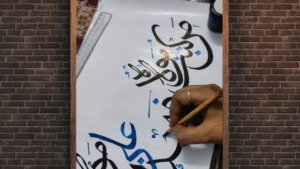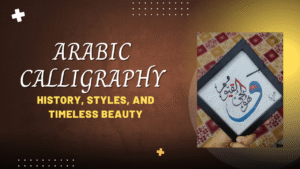In a world dominated by material visuals and fleeting trends, there exists a deeper form of beauty—sacred aesthetics. This concept transcends the surface and touches something eternal, connecting the human soul with the divine through art, symbolism, and spiritual intention. Sacred aesthetics are the foundation of many religious and cultural artistic expressions, especially visible in Islamic art, architecture, and calligraphy.
This article will explore the concept of sacred aesthetics, its historical roots, its expression in Islamic tradition, and its modern applications in decor, design, and mindful living. Whether you’re a spiritual seeker, designer, artist, or simply someone who appreciates meaningful beauty, understanding sacred aesthetics will open your eyes to a powerful dimension of artistic experience.
Table of Contents
What Are Sacred Aesthetics?
Sacred aesthetics refer to the visual, symbolic, and emotional beauty found in things that hold spiritual or divine meaning. This includes religious architecture, sacred symbols, calligraphy, chants, rituals, and objects created with deep intention and reverence.
In sacred aesthetics, beauty is not just decorative—it is purposeful, transcendent, and often used as a tool to connect with the Divine. Sacred aesthetics are universal and appear in all major traditions—Christian cathedrals, Buddhist mandalas, Hindu yantras, and especially in Islamic geometric patterns and Arabic calligraphy.
The Power of Beauty in Spiritual Traditions
Beauty in sacred traditions is not superficial—it is a form of knowledge, a pathway to the sacred, and a mirror of divine order.
- In Islam, beauty is a reflection of God’s perfection. The Prophet Muhammad ﷺ said, “Indeed, Allah is beautiful and loves beauty.”
- In Christian theology, beauty is seen as one of the divine attributes, alongside truth and goodness.
- In Hinduism and Buddhism, sacred patterns (mandalas, yantras) are used for meditation and inner alignment.
Hence, sacred aesthetics form a deep connection between art, the soul, and spiritual awakening.
Sacred Aesthetics in Islamic Art
Perhaps one of the finest expressions of sacred aesthetics is found in Islamic art and architecture. Islamic artistic traditions emphasize unity, symmetry, rhythm, and divine proportion. They avoid the depiction of living beings in religious contexts, choosing instead abstract forms to reflect spiritual harmony.
### 1. Arabic Calligraphy: The Language of the Divine
At the heart of sacred aesthetics in Islam lies Arabic calligraphy. Since the Quran was revealed in Arabic, writing became a sacred act.
- Styles like Thuluth, Kufic, and Naskh are not only artistic, but also spiritual.
- Calligraphers often prepare spiritually before writing Quranic verses—making the process a form of worship.
- Modern brands like Harfaura preserve this tradition by blending classical Arabic calligraphy with modern aesthetics for decor and meaning.
### 2. Geometric Patterns: Reflections of the Infinite
Islamic geometry uses repeating patterns to reflect God’s infinite nature and the interconnectedness of all creation.
- Eight-point stars, tessellations, and fractal-like designs symbolize unity through multiplicity.
- These patterns are not random—they are designed using precise ratios (sacred geometry), aligning them with cosmic order.
- Sacred aesthetics are embedded in these forms, which appear on walls, ceilings, tiles, and even carpets.
### 3. Mosque Architecture: Sacred Space Design
Mosques embody sacred aesthetics through:
- Domes representing the heavens
- Minarets reaching toward the Divine
- Mihrabs pointing toward Mecca
- Quranic calligraphy adorning the walls
Each element serves a spiritual purpose, guiding the heart and soul toward reflection and remembrance (dhikr).

The Philosophy Behind Sacred Aesthetics
At its core, sacred aesthetics are built on three spiritual principles:
1. Tawheed (Unity)
In Islam, sacred aesthetics reflect Oneness—the unity of God (Allah) and the harmony of creation.
2. Ihsan (Excellence & Beauty)
Excellence in creation and worship is encouraged. Beauty is seen as an act of ihsan.
3. Barakah (Spiritual Blessing)
Sacred objects and spaces are designed to invite barakah, or divine presence.
These concepts guide not only traditional Islamic art but also modern sacred design movements, including spiritual home decor, mindful art, and architecture.
Sacred Aesthetics in Modern Life and Design
In today’s world, sacred aesthetics are re-emerging in design, art, and wellness movements. People are turning to meaningful, spiritual decor to create peace and connection in their homes and lifestyles.
### 1. Sacred Home Decor
Brands like Harfaura create calligraphy wall art, geometric prints, and Islamic quotes that bring sacred beauty into everyday spaces.
Popular decor trends include:
- Arabic calligraphy panels for living rooms
- Quranic verses framed for study areas
- Geometric canvas art in bedrooms
- Minimalist sacred art for modern interiors
### 2. Mindful Spaces and Interior Design
Interior designers are incorporating sacred aesthetics to create environments that support reflection, prayer, or meditation.
- Natural materials, symmetry, and muted colors enhance spiritual presence.
- Prayer rooms with calligraphy, soft light, and sacred objects provide serenity.
### 3. Digital Sacred Aesthetics
Artists and creators are using digital tools to:
- Create modern Islamic art for Instagram, NFTs, and websites
- Share calligraphy tutorials online
- Launch spiritual art brands
Sacred aesthetics are no longer confined to temples and mosques—they now live on our screens, walls, and hearts.
Why Sacred Aesthetics Matter Today
In a time of distraction and overload, sacred aesthetics remind us of:
- Our spiritual roots
- The importance of inner balance
- The role of beauty in healing and connection
Whether through Islamic calligraphy, a peaceful home altar, or a geometrically aligned room, sacred aesthetics are an invitation to slow down, reconnect, and reflect.
FAQs about Sacred Aesthetics
Q1: What does sacred aesthetics mean?
Sacred aesthetics refers to artistic expressions that convey spiritual meaning, divine harmony, and religious symbolism. It’s beauty that points to the sacred.
Q2: How is sacred aesthetics different from normal design?
While normal design focuses on trends or function, sacred aesthetics are rooted in spiritual principles, intentionality, and often ritual use.
Q3: Why is Arabic calligraphy considered sacred?
Because the Quran was revealed in Arabic, writing it became an act of worship. The visual beauty of Arabic script carries deep spiritual power.
Q4: Can sacred aesthetics be applied in modern home decor?
Yes! Sacred aesthetics can be adapted into modern interiors using calligraphy art, geometric patterns, spiritual quotes, and calming design elements.
Q5: Is sacred aesthetics limited to Islam?
No, it’s found across many traditions—Christian stained glass, Hindu yantras, Buddhist mandalas, and Jewish Kabbalistic art all express sacred aesthetics.
Conclusion
Sacred aesthetics is not just an art style—it’s a philosophy of beauty that aligns the human experience with the divine. Through forms like Islamic art, Arabic calligraphy, and geometric designs, sacred aesthetics invite us to reflect, reconnect, and reawaken the soul.
In a chaotic world, embracing sacred aesthetics—whether through personal art, spiritual spaces, or mindful design—can be a powerful way to bring peace, presence, and meaning into everyday life.


